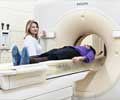Research presented by investigators at Thomas Jefferson University Hospital at the 51st ASTRO Annual Meeting says that positron emission tomography (PET) imaging of non-small cell lung cancer prior to receiving radiation therapy should not be the basis for determining areas that may benefit from higher doses of radiation.
Some studies suggest that areas that have the highest amount of hypermetabolic activity on PET scan before treatment are the areas most likely to have increased activity after treatment, according to Nitin Ohri, M.D., a resident in Radiation Oncology at Thomas Jefferson University Hospital. Dr. Ohri analyzed this theory in the Jefferson patient population."Investigators are looking to PET imaging find ways to predict if any part of the tumor would benefit from a higher radiation dose," Dr. Ohri said. "I wanted to see if residual activity on a scan after treatment correlates with the activity pattern on a scan done before treatment."
Dr. Ohri looked at the PET scans of 43 patients, of which 15 had significant activity on the scans both before and after treatment. He set up a coordinate system that divided tumors into nine regions or 17 regions for larger tumors. He then correlated the activity in the regions both before and after treatment.
He found that in some patients, the activity pattern was in similar regions before and after treatment. However, there were some patients who showed activity in completely different areas after treatment than there was before treatment.
"It's not sufficient to increase the dose to areas that are especially active on PET imaging before treatment and expect that to improve the control rate," Dr. Ohri said. "It may be more appropriate to do a scan halfway through treatment and plan additional radiation dose around that."
Source-Eurekalert
RAS











